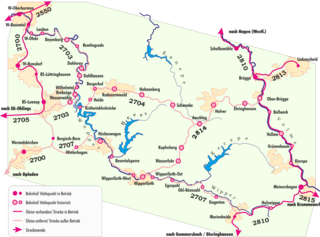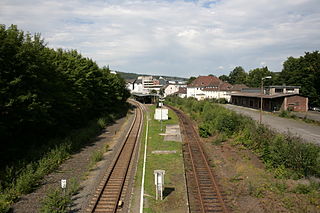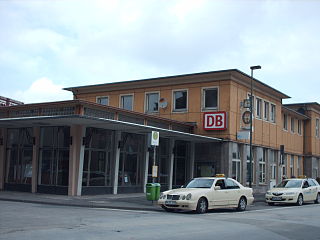
Rummenohl, now officially Hagen-Rummenohl, is a locality within the independent city of Hagen in the eastern part of the Ruhr region, in Germany. It lies in the valley of the river Volme, about 13 km upstream (south) of the city centre of Hagen.

Rummenohl, now officially Hagen-Rummenohl, is a locality within the independent city of Hagen in the eastern part of the Ruhr region, in Germany. It lies in the valley of the river Volme, about 13 km upstream (south) of the city centre of Hagen.
The former independent settlement of Dahl, consisting of Dahl, Priorei and Rummenohl, was incorporated in 1970 into the town of Breckerfeld in the district ( Kreis ) of Ennepe-Ruhr. In 1975, the Parliament of the state of North Rhine-Westphalia decided to transfer it to the metropolitan district of Hagen.
Rummenohl has for centuries been a centre of ironworking, using the power of the river Volme to process iron ore from the Siegerland. The opening on 16 March 1874 of the single-track Volmetalbahn, which made a connection for goods traffic to Brügge (Lüdenscheid) and beyond that to Meinerzhagen, improved its integration into the developing Ruhr. Goods traffic to Lüdenscheid via Brügge was discontinued in early 1996.
In the early 1870s, Alfred Nobel founded a factory in Rummenohl to manufacture dynamite. On 5 June 1910 it was struck by lightning and exploded.
Beginning in 1908, gunpowder was manufactured in the valley of the Sterbecke, which flows into the Volme in Rummenohl. In peacetime, 100 people worked there; during World War I, the number rose to over 2,000. In wartime, the factory primarily produced landmines, cartridges and charges for grenades; after the war, it once more produced explosives for road construction and mining. A spur railway connected the distant factory on the heights near Selkinghausen to the Volmetal-Bahn railway line, negotiating the difference in height by means of several switchbacks. Beginning in 1926, the factory was gradually closed down. After World War II, the buildings served as accommodations for bombing victims and refugees. The building was torn down in the 1960s in the course of construction of the A45 Autobahn.
In 1918, a new church was built. The grain mill and former smithy at Krummewiese, on the northern edge of Rummenohl, which had been in operation since 1824, was shut down in 1952.

The Ruhr is a river in western Germany, a right tributary (east-side) of the Rhine.

The Ruhr, also referred to as the Ruhr area, sometimes Ruhr district, Ruhr region, or Ruhr valley, is a polycentric urban area in North Rhine-Westphalia, Germany. With a population density of 2,800/km2 and a population of over 5 million (2017), it is the largest urban area in Germany. It consists of several large cities bordered by the rivers Ruhr to the south, Rhine to the west, and Lippe to the north. In the southwest it borders the Bergisches Land. It is considered part of the larger Rhine-Ruhr metropolitan region of more than 10 million people, which is the third largest in Western Europe, behind only London and Paris.

Hagen is a city in the state of North Rhine-Westphalia, Germany, on the southeastern edge of the Ruhr area, 15 km south of Dortmund, where the rivers Lenne and Volme meet the Ruhr. In 2010, the population was 188,529.

Lüdenscheid is a city in the Märkischer Kreis district, in North Rhine-Westphalia, Germany. It is located in the Sauerland region.

The Sauerland is a rural, hilly area spreading across most of the south-eastern part of North Rhine-Westphalia, in parts heavily forested and, apart from the major valleys, sparsely inhabited.

Dahl, now officially Hagen-Dahl, is a locality within the independent city of Hagen in the southeastern Ruhr, in Germany. It was incorporated into Hagen in 1975 together with Rummenohl and Priorei.

Priorei is a small town on the River Volme in the Ruhr district of Germany. Administratively a part of the independent urban district of Hagen since 1975, it is situated some 12 km south of Hagen city centre.

The Volme is a river in North Rhine-Westphalia, Germany, and is a tributary of the river Ruhr. It is 50.5 kilometres (31.4 mi) long, of which about 21 km (13 mi) lie within the city limits of Hagen. Its largest tributary is the Ennepe.

Elspe is a right tributary of the Volme river in Germany. Its source is at 413 metres above sea-level near Brenscheid, just south of Piepersloh, a part of the city Lüdenscheid. It empties at 270 metres above sea-level into the Volme in Brügge, another part of Lüdenscheid. The Elspe is separated from the Lüdenscheid's built up area by the Nurre mountain range. It makes two 90° turns.

The Ruhr Valley Railway is a partly abandoned railway line in the German state of North Rhine-Westphalia, running from Düsseldorf-Rath via Old Kupferdreh station, Bochum-Dahlhausen, Witten-Herbede, Hagen-Vorhalle and Schwerte to Warburg. It was built between 1872 and 1876 by the Bergisch-Märkische Railway Company, one of the three major private railway companies in the Ruhr area. The railway tracks that were built along the Ruhr river had a relatively uniform grade that was suitable for railway operations at the time.

The Ruhr–Sieg railway is a 106 km long double-track, electrified main line from Hagen to Siegen via Iserlohn-Letmathe, Finnentrop and Kreuztal in the German state of North Rhine-Westphalia. The line, which has many tunnels, runs primarily through the valley of the Lenne. South of Altenhundem it crosses the watershed between the Lenne and the Sieg. The line was opened between 1859 and 1861 and is one of the oldest railways in Germany.

The Siegburg–Olpe railway or Agger Valley Railway is a single-tracked, non-electrified branch line in the German state of North Rhine-Westphalia. Part of a direct link from Cologne, only the section from Overath to Gummersbach-Dieringhausen is still in operation. The section of line from Siegburg to Overath and from Dieringhausen to Olpe are closed.
The Düsseldorf-Derendorf–Dortmund Süd railway is a partially closed line in the German state of North Rhine-Westphalia from Düsseldorf-Derendorf station to Dortmund South station. Parts of it are still busy, including two sections used for the Rhine-Ruhr S-Bahn.

The Hagen–Dieringhausen railway is a mostly single-track and non-electrified railway line from Hagen Hauptbahnhof via Lüdenscheid-Brügge, Meinerzhagen and Gummersbach to Gummersbach-Dieringhausen in the German state of North Rhine-Westphalia.

Gummersbach station is on the Hagen–Dieringhausen railway and serves central Gummersbach in the Oberbergische district. Until the 1980s, Dieringhausen station, which is also in Gummersbach, was more important for the city as it had a rail workshop and was a railway junction. Gummersbach station only became more important with the closing of branch lines in the Oberbergische district and the associated loss of significance for Dieringhausen.
The Oberbergische Bahn is a Regionalbahn rail service running between Cologne Hansaring and Lüdenscheid in the German state of North Rhine-Westphalia (NRW).

The Brügge–Lüdenscheid railway is a single-track, non-electrified branch line in the German state of North Rhine-Westphalia. The 7 km-long line climbs from Lüdenscheid-Brügge station on the Hagen–Dieringhausen railway to Lüdenscheid station.

Lüdenscheid-Brügge station is on the Hagen–Dieringhausen railway from Hagen Hauptbahnhof to Dieringhausen station in the German state of North Rhine-Westphalia. It is classified by Deutsche Bahn as a category 7 station. Because of the branch line to Lüdenscheid, it is classified as a separation station. The station is located on the edge of the Lüdenscheid hamlet of Brügge. There is an island platform with tracks which connects with the bus stop at ground level. The station is known nationally for its elevated disused but preserved signalbox. The station was called Brügge (Westfalen) until 10 December 2017.

Lüdenscheid station is the terminus of a single-track branch line from Lüdenscheid-Brügge to Lüdenscheid in the German state of North Rhine-Westphalia. It branches in Brügge from the Hagen–Dieringhausen railway. It is classified by DB Station&Service as a category 6 station.
The Sauerland Net is a group of railway services in the western Sauerland and the eastern Ruhr of the German state of North Rhine-Westphalia and consists of four Regionalbahn services, RB 43 (Dortmund–Dorsten), RB 52 (Dortmund–Hagen–Lüdenscheid), RB 53 (Dortmund–Schwerte–Iserlohn) and RB 54 (Unna–Fröndenberg–Menden–Neuenrade), and the Regional-Express service RE 57. The RB 43 also carries the brand name of the Emschertal-Bahn, the RB 52 is called the Volmetal-Bahn, the RB 53 is called the Ardey-Bahn, the RB 54 is called the Hönnetal-Bahn and the RE 57 is called the Dortmund Sauerland-Express. In December 2004, DB Regio NRW took over or retained operations of these services. Previously the RB 53, RB 54 and RE 57 had been operated by DB Regio NRW and RB 52 had been operated by the Dortmund-Märkische Eisenbahn (DME).